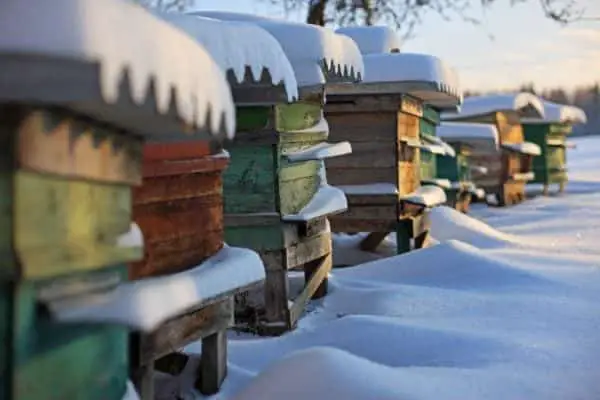
Unlike us humans, bees can not just put on a sweater or a jacket when it gets cold outside in the winter months. Bees typically live in hives that are outside and exposed to the elements, they don’t have central heating like we do to warm their homes during cold winters. Yet clearly bees have found ways to survive the winter. How is it possible for a colony of bees to survive months of below-freezing weather?
How do bees survive the Winter? If outside temperatures are below 14℃ (57℉) bees return to their hives. Bees cluster together tightly in the hive, vibrating their bodies to generate heat, keeping the internal temperatures of the cluster at about 35℃ (95℉). The bees consume their stored honey as heating their hive burns energy.
Bees are resilient little characters, they are very efficient and plan well. They understand the weather and the seasons. Left to their own devices bees have learned to survive long Winters in hollows of trees and other spaces like wall cavities of houses.
Let’s take a deeper look at the methods and planning bees put in place to survive the winter. We will look at some ways beekeepers can help their hives make it through the winter in good shape to hit the ground running in Spring
What Temperature Do Bees Stop Flying And Stay In Their Hive?
Active foraging flights by the worker bees in the field will stop around 57℉ (14℃). At this point, most of the bees will have returned to the hive for warmth. Bees can still fly at temperatures below 57℉ (14℃) however typically these are not foraging flights, they are usually short cleansing flights.
These cleansing flights can occur down to about 44℉ (6.5℃) and often happen when the temperature reaches this threshold after days of the bees being confined to their hive because of cold outside temperatures.
The risk for bees flying in such cold conditions is that if their body temperature drops below 50℉ (10℃) paralysis of their muscles begins to occur. If the bees’ body temperature drops below 45℉ (7℃) their muscles will freeze up and the bee will die.
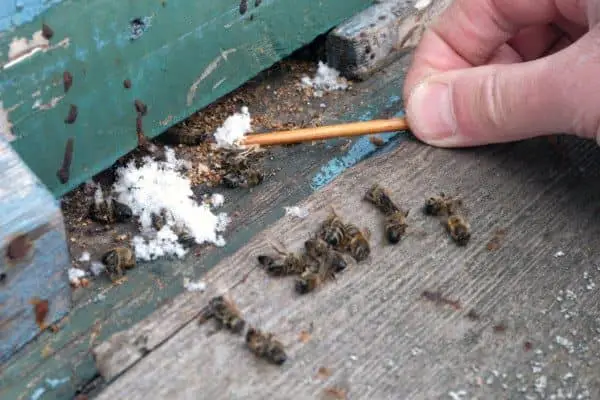
When bees are doing cleansing flights they will leave the warmth of the cluster within the hive. Once flying they are able to maintain some body heat because their flight muscles are generating heat through activity.
The wind chill is very risky and can rapidly drop the effective outside temperature below what the bee can handle. The hazardous time is the moment they are exposed to the cold from when they land. The timeframe in which they are able to return to the warmth of the cluster is crucial.
In saying that, bees will also stop flying in Summer when temperatures reach about 110℉ (43℃). In hot weather, bees will cool the hive by creating a draft through their hive by fanning their wings.
How Do Bees Maintain The Temperature Needed In The Hive?
The optimum temperature the bees are trying to achieve inside the hive is about 95℉ (35℃). This is the temperature needed for maintaining the brood.
During the colder months, the bees adopt a similar method to that of the penguins in Antarctica, who are able to keep warm in the coldest of conditions. Penguins huddle together with each individual taking its turn on the outer edge before returning to the warmth of the protected middle.
Similarly, the bees will cluster tightly around the brood nest in the hive maintaining heat around the queen and her brood nest. Each worker bee will take its turn rotating to the outer edge of the cluster.
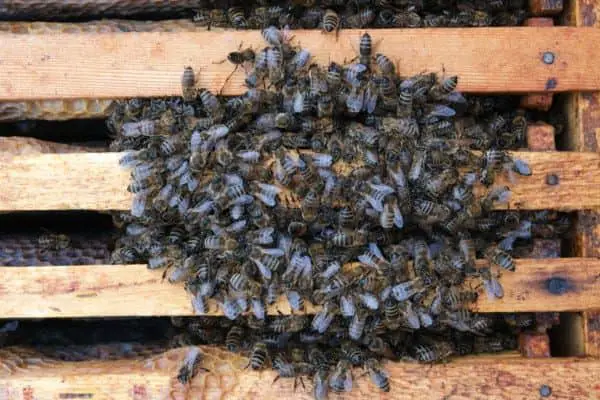
From about 64℉ (18℃) field bees out foraging will begin returning to the hive and some clustering may begin to occur. This is dependent on the number of bees in the hive. A hive with only a small number of bees will need to begin clustering before a strong hive with many bees.
Beekeepers should try and have strong hives with little free space coming into winter. This helps the bees to more efficiently maintain hive temperatures.
When the outside temperature reaches 57℉ (14℃) most bees are in the hive. At about 48℉ (14℃) a defined cluster will have formed.
The bees are targeting 95℉ (35℃) for the middle of the cluster. The bees have the ability to become mini heaters by vigorously vibrating the muscles in their abdomen and their flight muscles. In doing this they are able to raise their body temperature to about 111℉ (44℃).
Research has shown that when a worker bee crawls into an empty cell and switches to the “heater bee” state they are able to heat up to brood cells within a three cell radius. This equates to up to 70 cells around them.
The bees on the outer edge of the cluster also become heater bees. This action burns up energy and these bees need to rotate back into the cluster to refuel feeding on honey or sugar water supplement that their beekeeper may have provided.
If a hive does not have enough honey or enough bees to maintain sufficient heat to keep the queen and her small winter brood nest alive, then the hive is at high risk of not making it through the winter.
How Do Beekeepers Help Their Bees Survive The Winter?
This is a bit subjective depending on what the winter in your location delivers. In tropical and subtropical areas you probably don’t need to do too much other than make sure you have left some frames of honey on the hive as a buffer for winter. In these areas, the hives will typically bring in some pollen and nectar through the season.
If you do live in an area where there are weeks or months of temperatures below 57℉ (14℃), you will need to apply some strategies that will help your bees come through the Winter fighting fit:
1. Sufficient Honey Stores
Ensure your hives have sufficient honey stores for the winter. In cold areas of the northern United States and Canada typically beehives will consume up to 90 pounds (40Kg) of honey during the long winter months. The shorter and milder the winter, then less honey will be needed in stores using this colder season.
2. Food Supplements
Installation of sugar-water feeders and pollen patties on or in your hive in the fall is a way to help ensure your beehives have enough feed coming into and through the winter. Again the need for this will vary according to the natural availability of pollen and nectar in your area.
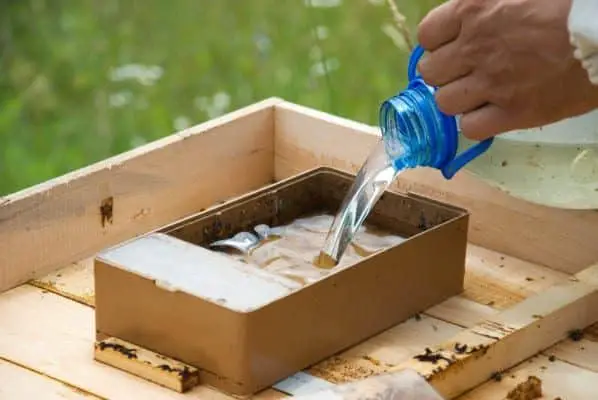
3. Beehive Strength
Check the health of the brood. Ideally, you want the queen laying well in the fall ensuring there are plenty of bees coming into the winter. The ability for a hive to generate heat and maintain good hive temperature in the coldest of winters is much better with lots of bees to share that load, as long as there is sufficient food.
If you have a couple of weaker hives it is worth looking at merging those hives to create a stronger hive. This will give them a better chance of wintering well and hitting the ground running into spring. If you don’t merge the two weak hives you may lose them both. You can always split them again in the spring if the hive is strong.
4. Good Ventilation
It is tempting to make sure the beehive is sealed up well. This is a good idea to a point however, you need to ensure there is ventilation on the lid of the hive. The entrance of the hive should also be significantly reduced however it is important that air can flow in through the entrance and vent out the top of the hive.
If the hive is not well ventilated there is a risk of moisture build-up in the hive which can lead to Nosema. Nosema is like dysentery in bees.
5. Pest Management
This is something that you should really be onto all year round as a responsible beekeeper. If your hive has disease or pest issues coming into winter then it is going to really struggle to make it through the winter.
Furthermore, a weak hive is at a high risk of being robbed in the fall and winter as resources become less available. This will expose your other hives and other beekeepers hives in the area, to a high risk of getting the pest or disease that the hive has through robber bees taking it back to their hive.
We have articles that cover in detail a couple of threats to your hive:
- Chalkbrood – Know it, Identify it, Beat it
- American Foulbrood Disease – Know it, Identify it, Beat it
6. Removal Of The Queen Excluder
Queen excluders are often used during the spring and summer to keep the queen in the bottom one or two boxes. This means that she has her brood nest confined to these boxes, allowing the supers above the excluder for honey storage.
This is great for ease of robbing frames of honey as you can be pretty certain there will be no brood and no queen in the honey supers when you rob them.
During winter though you should remove the queen excluder, if the hive has not been reduced to one box, as the cluster will typically move around as they consume the stored honey. You want the queen to be able to move freely throughout the hive at this time. In spring, the queen excluder can be put back in place.
We have another article on queen excluders that takes an in-depth look at queen excludes, when you should use them, and the pros and cons of queen excluders. The article is called, How Does A Queen Bee Excluder Work? Do You Need Them?
7. Painting Beehives In Dark Colors
It is a well-known fact that dark colors absorb heat and that light colors will reflect heat. In regions with hot summer temperatures hives are painted white. We keep beehives in the state of Queensland in the north of Australia where the winter is mild and summers are hot. All of our hives are painted white to reflect the heat.
In cold climates, it is a good practice to paint your hives in dark colors. This will certainly help your bees in the fall and coming into spring when sunny days can still be quite cool.
We actually have a whole article on the ins and outs of painting your beehives. The article is called, Painting Your Beehives: Your Complete Guide.
8. Insulation Of The Beehive
In the northern areas of the United States and Canada where the winters are very cold and months in duration beekeepers will place temporary insulation on or around their beehives.
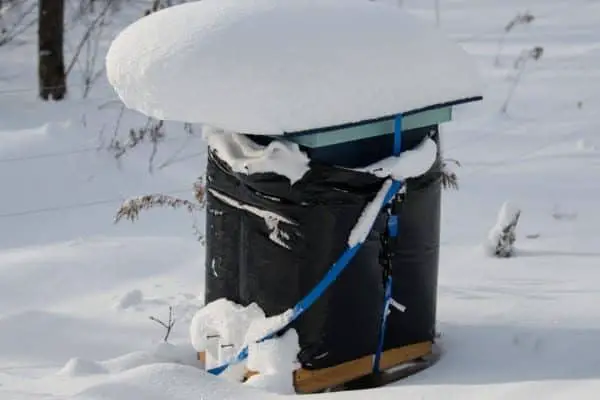
Some beekeepers will wrap their hives in materials that add insulating properties to the hive, kind of like putting an extra blanket on your bed on a cold night. Polystyrene sheet about 1 inch (25mm) thick is popular.
There are some advantages in doing this. The bees will consume less of the honey stores as they will not have to work as hard to maintain the hive temperature. The warmer internal temperature also will allow for a more mobile cluster meaning better access to honey stores.
The insulation also reduces the amount of condensation on the inside of the hive and therefore reduces the chances of Nosema.
Some beekeepers in very cold climates will transfer their hives to shelters so they are protected from snow, ice and winter wind chill. Some beekeepers even bring their beehives indoors keeping them in a dark ventilated room until spring breaks. Take a look at this video below of a commercial beekeeper from Canada who keeps almost his whole apiary indoors during the winter.
Do beehives Stop Producing Honey Over Winter?
This is an interesting one, the answer to this is both yes and no. There are a number of factors that will determine whether a beehive will produce honey during the winter.
Let’s take a closer look at those:
1. Location
In regions that are subject to extreme seasons, especially those with consistently cold weather and snow through winter. The outside temperature will be too cold for bees to leave the hive and no honey will be produced.
In these locations, even if they could leave the hive it is a frozen dessert, with many plants without foliage let alone flowers containing pollen and nectar.
In locations where winters are mild, bees will still be able to forage for nectar and pollen. However, typically there are sparse resources available with fewer species of plants flowering in winter.
We live in the state of Queensland in Australia which on the whole has very mild winters particularly close to the coast. Some of our native trees flower during winter meaning we can get short honey flows often only lasting for two or three weeks. These honey flows are not as strong as those we get in spring and summer.
There are some winter seasons where the short honey flows are strong enough that we can actually rob some honey from our hives. For the most part, though we will often leave the honey on the hive until spring to avoid honey we rob from candying in storage.
2. Outside Temperatures
As the outside temperature cools off during winter or even late fall the foraging activity of the bees will drop off. The bees will start foraging later in the day waiting for the day to warm up and they will finish earlier in the day as temperatures fall. On cloudy or wet days where temperatures stay low, the bees will not even leave the hive.
3. Shorter Days
The hours of sunlight in the day can be significantly less in winter than in summer. The actual amount of hours of sunlight in winter compared to summer will vary depending on your location throughout the world.
It’s important to remember that even if the temperature is warm enough for the bees to forage all day, there are simply less available hours for foraging. So even if there were the same availability of resources as summer, the bees would not be able to produce the same quantities of honey as they do in summer.
4. Less Bees
As the weather gets colder and the resources become less abundant the queen will lay fewer eggs, in turn resulting in less brood. Less brood means fewer bees. Bees are habitually good managers of their resources; they do their best to store pollen and honey for the winter for survival.
The bees will live longer in the winter because they spend more time inside their hive. Ultimately bees die from worn-out wings when foraging. With little or no foraging going throughout winter, the worker bees don’t need to be replaced anywhere near as often.
You do not want to be a drone bee come Wintertime. As the temperature drops moving into the cooler months, the queen will cease producing drones. The existing drones now redundant, will be kicked out of the hive into the cold where they rapidly die from exposure to the elements.
This happens because the drones impart limited contribution to the upkeep of the hive. Drones are also physically bigger than worker bees meaning they will consume larger quantities of valuable resources during the winter.
The Wrap Up
Winter is a high-risk time for bees, however, during a normal season, left to their own devices a healthy hive is able to store enough resources to survive the winter. They work efficiently, selflessly working together to keep the hive warm through a long winter.
Beehives being kept by a beekeeper for the purpose of honey production can be assisted with food supplements and hive insulation to give them a flying start into the spring. Therefore, beekeepers need to be planning for the winter months in order to maximize the honey production of their hives during the spring and summer.
